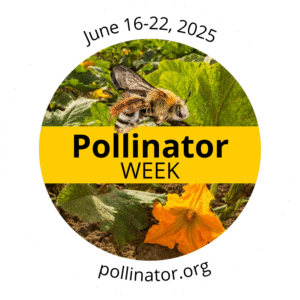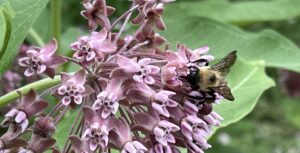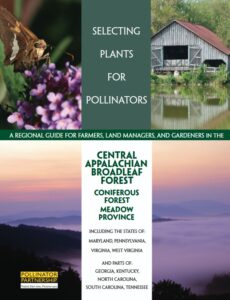(Posted June 18, 2025)
Did you have a cup of coffee this morning? A banana or blueberries with your cereal? Then thank a pollinator.
This week—June 16-22—is National Pollinator Week, a time to celebrate all the essential gifts that pollinators bring to us, including a lot of what we typically have for breakfast.
 According to the U.S. Department of Agriculture, three-fourths of the world’s flowering plants and about 35 percent of the world’s food crops rely on animal pollinators to reproduce. This means that one out of every three bites of food we eat depends on creatures such as bees, butterflies, moths, and beetles, as well as birds and bats. Apples, strawberries, melons, peaches, potatoes, vanilla, almonds, even chocolate—these are just a small sampling of food crops dependent on pollinators.
According to the U.S. Department of Agriculture, three-fourths of the world’s flowering plants and about 35 percent of the world’s food crops rely on animal pollinators to reproduce. This means that one out of every three bites of food we eat depends on creatures such as bees, butterflies, moths, and beetles, as well as birds and bats. Apples, strawberries, melons, peaches, potatoes, vanilla, almonds, even chocolate—these are just a small sampling of food crops dependent on pollinators.
Pollination—the transfer of pollen from the male part of a flower (anther) to the female part (stigma)—is necessary for plants to produce fruits and seeds. Some plants, such as pine trees and most other conifers, are wind pollinated. For many other plants, pollination happens when, say, a foraging bee or a nectar-seeking hummingbird accidentally picks up pollen from one flower and transfers it to another of the same species. It’s one of nature’s neatest tricks.
Unfortunately, our pollinators are struggling. Habitat loss, disease, parasites, chemical pollutants, and weather extremes are all putting pressure on pollinator species, including honeybees and the approximately 4,000 native bee species found in our country. North American bumblebees have been especially hard hit, according to the U.S. Fish and Wildlife Service. Their numbers have dropped by nearly 50 percent since 1974.
One factor in these declines is insufficient pollinator-friendly plantings in our landscapes, according to the USDA. This is a problem we home gardeners can help solve.
There are abundant reliable resources online that will help you provide food, shelter, and nesting places for pollinators on your property. Among them are region-specific planting guides created by the Pollinator Partnership, the organization behind National Pollinator Week.
 Plug the 22901 Zip Code into a form on their website, and you will find that the Charlottesville area falls into the Central Appalachian Broadleaf Forest-Coniferous Forest-Meadow Province. The downloadable planting guide for this region (shown at left) includes a four-page chart that lists recommended pollinator plants and their bloom times. “Choose a variety of flower colors,” it advises, “and make sure something is blooming at all times.”
Plug the 22901 Zip Code into a form on their website, and you will find that the Charlottesville area falls into the Central Appalachian Broadleaf Forest-Coniferous Forest-Meadow Province. The downloadable planting guide for this region (shown at left) includes a four-page chart that lists recommended pollinator plants and their bloom times. “Choose a variety of flower colors,” it advises, “and make sure something is blooming at all times.”
You can also check out the Native Plants page on the Piedmont Master Gardeners’ website. It includes a recently updated list of native plants and appropriate cultivars for the Northern Piedmont region, encompassing Albemarle, Greene, Madison, Orange, Louisa, Nelson, Buckingham, Culpeper, Rappahannock, and Fauquier Counties. You will also find the list of pollinator plants selected for the Rose and Pollinator Demonstration Gardens the Piedmont Master Gardeners developed and help maintain at The Center at Belvedere.
Better yet, come see them for yourself on Saturday, June 21. In recognition of National Pollinator Week, Master Gardeners will conduct tours at 9 a.m., 10 a.m. and 11 a.m. at each of three local gardens: The Rose and Pollinator Gardens at The Center at Belvedere, 540 Belvedere Blvd. (off East Rio Road); the Sentara Martha Jefferson Hospital Demonstration Garden, 500 Martha Jefferson Dr.; and the Bread & Roses Gardens at Trinity Episcopal Church, 1118 Preston Ave.
The three gardens serve as outdoor classrooms and showcase best practices for conserving resources and providing food and habitat or pollinators and other wildlife. Learn more about them on our Events page.
You will also find inspiration by visiting the pollinator garden at the Ivy Creek Natural Area, 1780 Earlysville Road. Planted near the ICNA Education Building, the garden was established in 2017 to support pollinators and other insects and to provide a learning resource for visitors. Labels and other information onsite and online will help you identify the native plants on display.
And here’s a simple thing you can do for pollinators: leave dandelions in your lawn. These nonnatives are among the first food sources for bees to come out in the spring.